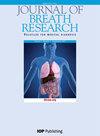探索职业性哮喘患者呼出气体中的挥发性有机化合物:一项试点横断面研究。
IF 3.4
4区 医学
Q1 BIOCHEMICAL RESEARCH METHODS
引用次数: 0
摘要
职业性哮喘(OA)分为过敏性哮喘(AA)和刺激性哮喘(IIA)。IIA 又可分为三种不同的表型亚型。呼出气体中的挥发性有机化合物(VOCs)可以反映人体的新陈代谢变化,在过去二十年中,有多种挥发性有机化合物与各种疾病相关。这是第一项对患有 OA 的受试者进行呼出气体挥发性有机化合物检测的已知研究,旨在确定潜在的生物标志物,以区分 OA 和健康对照组,以及不同 OA 亚组之间的差异。在一项横断面调查中,研究人员使用 ReCIVA® 呼吸采样器收集了 40 名 OA 患者和 45 名呼吸系统健康的医护人员的呼出气体。采用热脱附-气相色谱质谱法(TD-GC-MS)对样本进行了非靶向分析,并根据等级分类确定了挥发性有机化合物。使用非参数和参数统计方法对数据进行了分析。共鉴定出 536 种挥发性有机化合物。在几种排放的挥发性有机化合物中观察到了显著性(p<0.05)。其中,1-十六烷醇、2,3-丁二醇、二甲苯、苯酚、丙酮、3-甲基己烷、甲基环己烷和异戊二烯等化合物对生物有影响,或与 OA 暴露有关。特别是,1-十六醇、2,3-丁二醇、二甲苯和苯酚与烟酰胺腺嘌呤二核苷酸(NADH)的减少和活性氧(ROS)的产生有关,这些机制可能与哮喘疾病有关,因此表明它们有可能成为生物标记物。这项研究表明,呼出气体中检测到的挥发性有机化合物可以作为职业暴露的指标,并提高哮喘诊断的准确性。本文章由计算机程序翻译,如有差异,请以英文原文为准。
Exploring exhaled breath volatile organic compounds in occupational asthma: A pilot cross-sectional study.
Occupational asthma (OA) is divided into allergic asthma (AA) and irritant-induced asthma (IIA). IIA can be divided further into three different phenotypic subtypes. Volatile organic compounds (VOCs) in exhaled breath can reflect metabolic changes in the body, and a wide range of them have been associated with various diseases in the last two decades. This is the first known study to explore breath VOCs in subjects with OA, aimed to identify potential biomarkers to distinguish OA from healthy controls, as well as between different OA subgroups. In a cross-sectional investigation, exhaled breath from 40 patients with OA and 45 respiratory healthy healthcare workers were collected with ReCIVA® Breath Sampler. Samples were analyzed through an untargeted approach using thermal desorption-gas chromatography mass spectrometry (TD-GC-MS), and VOCs were identified according to tier classification. The data underwent analysis using both non-parametric and parametric statistical methods. 536 VOCs were identified. Significance (p<0.05) was observed in several emitted VOCs. Among these, compounds such as 1-hexadecanol, 2,3-butanediol, xylene, phenol, acetone, 3-methylhexane, methylcyclohexane, and isoprene have biological implications or are associated with exposures linked to OA. These VOCs may reflect metabolic changes in the body and the microbiome, as well as external exposures due to occupation.
In particular, 1-hexadecanol, 2,3-butanediol, xylene and phenol are associated with reduced nicotinamide adenine dinucleotide (NADH) and production of reactive oxygen species (ROS), mechanisms that can be linked to asthmatic diseases and therefore suggests its potential as biomarkers. This study demonstrates that VOCs detected in exhaled breath could serve as indicators of occupational exposure and enhance diagnostic accuracy for asthma.
.
求助全文
通过发布文献求助,成功后即可免费获取论文全文。
去求助
来源期刊

Journal of breath research
BIOCHEMICAL RESEARCH METHODS-RESPIRATORY SYSTEM
CiteScore
7.60
自引率
21.10%
发文量
49
审稿时长
>12 weeks
期刊介绍:
Journal of Breath Research is dedicated to all aspects of scientific breath research. The traditional focus is on analysis of volatile compounds and aerosols in exhaled breath for the investigation of exogenous exposures, metabolism, toxicology, health status and the diagnosis of disease and breath odours. The journal also welcomes other breath-related topics.
Typical areas of interest include:
Big laboratory instrumentation: describing new state-of-the-art analytical instrumentation capable of performing high-resolution discovery and targeted breath research; exploiting complex technologies drawn from other areas of biochemistry and genetics for breath research.
Engineering solutions: developing new breath sampling technologies for condensate and aerosols, for chemical and optical sensors, for extraction and sample preparation methods, for automation and standardization, and for multiplex analyses to preserve the breath matrix and facilitating analytical throughput. Measure exhaled constituents (e.g. CO2, acetone, isoprene) as markers of human presence or mitigate such contaminants in enclosed environments.
Human and animal in vivo studies: decoding the ''breath exposome'', implementing exposure and intervention studies, performing cross-sectional and case-control research, assaying immune and inflammatory response, and testing mammalian host response to infections and exogenous exposures to develop information directly applicable to systems biology. Studying inhalation toxicology; inhaled breath as a source of internal dose; resultant blood, breath and urinary biomarkers linked to inhalation pathway.
Cellular and molecular level in vitro studies.
Clinical, pharmacological and forensic applications.
Mathematical, statistical and graphical data interpretation.
 求助内容:
求助内容: 应助结果提醒方式:
应助结果提醒方式:


